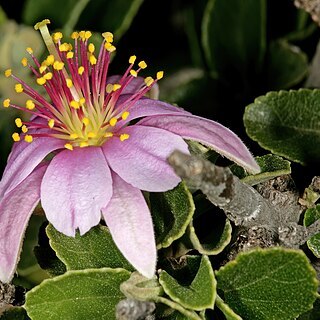Small shrub, up to 3 m high; bark greyish purple. Leaves clustered on abbreviated side shoots; broadly elliptic to rotund, up to 20 x 16 mm, apex obtuse, base rounded, margins finely crenate. Inflorescences reduced to a single flower opposite leaves; peduncles 2-3 mm long, tomentellous. Flowers ± 15 mm long, pink or mauve. Sepals linear-lanceolate, up to 15 mm long. Petals shorter than sepals. Androgynophore with a basal glabrous portion of ± 1 mm long, tomentose at apex. Flowering time Aug.-May. Fruit purplish, ± 14 mm in diam., deeply 4-lobed, somewhat fleshy.
Shrub, up to 3 m tall, grey-velvety when young. Leaves discolorous, grey-velvety beneath, often clustered on short shoots, ovate, finely toothed. Flowers solitary opposite leaves, pink. Fruit 4-lobed, purplish.
Shrub to 3 m, grey-velvety when young. Leaves discolorous, grey-velvety beneath, often clustered on short shoots, ovate, finely toothed. Flowers solitary opposite leaves, pink. Fruits 4-lobed, purplish.
An erect evergreen shrub.

